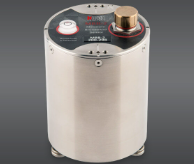Kinemetrics MBB-2
Salient Features
The MBB-2 is a compact, triaxial broadband seismometer engineered for high-performance seismic monitoring in a wide range of environments. Built into a durable, passivated stainless steel housing, the MBB-2 provides a velocity-sensitive output across a broad frequency passband from 120 seconds to 150 Hz. With a nominal sensitivity of 750 V·s/m and low self-noise, it is capable of capturing both small ground motions and large seismic events with precision.
Hz. With a nominal sensitivity of 750 V·s/m and low self-noise, it is capable of capturing both small ground motions and large seismic events with precision.
Designed for shallow borehole and posthole deployments, the MBB-2 supports a full-scale tilt range of ±2.5 degrees and requires no manual adjustments or internal servicing. It is compatible with standard Quanterra Q330 and Kinemetrics Rock series digitizers and draws operating power directly from the connected system. All outputs are differential, and the unit includes mass position monitoring, period switching for fast settling, and differential calibration input.
At just 4.5 pounds, the MBB-2 combines portability with rugged performance. It is well suited for rapid-deploy stations, long-term field arrays, and research-grade observatory installations where space and stability are essential.
Installation Tips
The MBB-2 is designed for straightforward deployment with minimal site preparation. It ships with either half-ball stainless feet for simple drop-in placement or threaded leveling feet for uneven surfaces. The sensor includes a top-mounted bolt pattern to support lifting aids and azimuthal alignment tools for accurate orientation.
For standard installation, the sensor is powered and controlled through its oceanographic-grade Glenair connector and supplied cable. Apply a small amount of silicone grease to the connector during assembly to ensure a watertight seal. Take care not to overtighten or lift the sensor by the cable, as this may damage the connection.
At startup, the MBB-2 automatically enters a 1-second setup mode to allow rapid settling of internal electronics. After approximately one minute, it transitions into its standard 120-second mode. If repositioning or moving the sensor under power, users may manually trigger the setup mode using the designated control line to shorten recovery time.
Leveling can be assessed using the built-in bubble level, and tilt diagnostics are available via the mass position outputs on the horizontal channels. These outputs can also be used to proxy tilt angle, with an approximate scale factor of 4 V per degree.
Manufacturer’s Documents
For technical assistance and the most current product resources, visit:
-
Metrozet Product Site: www.metrozet.com
-
Kinemetrics Partner Site: www.kinemetrics.com
- Home
- General Information
- Instrumentation
- Dataloggers
- Sensors
- All-In-One Systems
- Power Systems
- Field Procedures
- Controlled Sources
- Seismic Source Facility
- Magnetotelluric Systems at EPIC
- Ground Penetrating Radar
- GNSS/GPS Receivers
- Power and Memory Calculations Form
- Data Archiving
- Apply for a PI Account
- Experiment Scheduling
- Polar
- Hardware & Software Notes
- Software


